Contents
- China, better prepared for the post-COVID world
- Grasping the defence self-reliance nettle
- India-China conflict in Ladakh
CHINA, BETTER PREPARED FOR THE POST-COVID WORLD
Focus: GS-III Indian Economy
Deep economic impact
- India has surpassed China with regard to the number of confirmed COVID-19 cases, and the economic impact is quite threatening.
- India’s exports in the month of April 2020 were the worst in the past 30 years.
- Well before this, India had been witnessing a persistent economic downward slide. The pandemic could, thus, not have come at a more inopportune moment.
- India has already had to resort to a second tranche of $1 billion loan from the World Bank to support COVID-19 relief measures.
India’s Package is more a mosaic
Several important segments of the Economic Stimulus Package are:
- Providing a stimulus to Micro, Small and Medium Enterprises (MSMEs) through a ₹3-lakh crore loan scheme
- Hhelping other stressed business sectors such as non-banking financial companies, or NBFCs, power distribution companies and the real estate industry
- Provisioning of free food grains to migrant workers for the next two months
- Provisioning of a ₹1-lakh crore subsidy to agricultural cooperative societies
- Hiking the allocation for the Mahatma Gandhi National Rural Employment Guarantee Scheme, or MGNREGS, by ₹40,000 crore
- Extension of credit facilities to street vendors; interest subvention for small businesses, etc.
In the list of items mentioned as part of the stimulus package are references to opening up of defence and aerospace for private companies, support to budgetary provisions for domestic defence procurement, bringing out a negative import list of weapons and military platforms, etc.
China’s calibrated moves- Route to Global Dominance
- China has embarked on not only attaining economic and technological progress but also in defining how power would be determined in the new globalised era through devising new international norms in many emerging domains such as cyber, space, artificial intelligence, etc.
- China also set about rewriting international rules, premised not so much on governing where global goods are made, but on setting standards that define production, exchange and consumption.
- China Standards 2035 plans to set new standards with regard to the Industrial Internet of Things (IIoT) and define next generation information technology and biotechnology infrastructure.
- Internationalisation of Chinese standards would provide China a clear advantage by providing it an opportunity to set the standards in emerging industries such as high-end equipment manufacturing, unmanned vehicles, new materials, cybersecurity and the like.
- This would enable it gain a dominant position in the global economy.
India must plan well
- Both China and Indiawill, no doubt, suffer an economic setback, but while both nations would be among the very few that would still have a positive growth rate in the near future – 1% in the case of China and 1.8% in the case of India, according to the International Monetary Fund.
- Even though India, Growth rate is 1.8%, given the size of China’s economy, it does not translate into a massive shift in India’s favour.
- However, there is a great deal of talk of companies demitting China at this time, partly due to the pandemic and partly due to other reasons.
- India would more than welcome some of the entities exiting China, but there are no “green shoots” to suggest that such a shift has, or is, about to take place.
- Many alternatives are available to these companies and India must put the effort to have them consider India.
Analysis: Where did Companies in China go in the past?
- Companies started leaving China when the trade war between the United States and China started shaking up supply chains all over the world in September 2019.
- Companies such as manufacturers of electronics, apparel and electrical equipment, headed to neighboring Vietnam, Taiwan and Thailand in droves. They also resorted to reloacting in places like Mexico and the U.S.
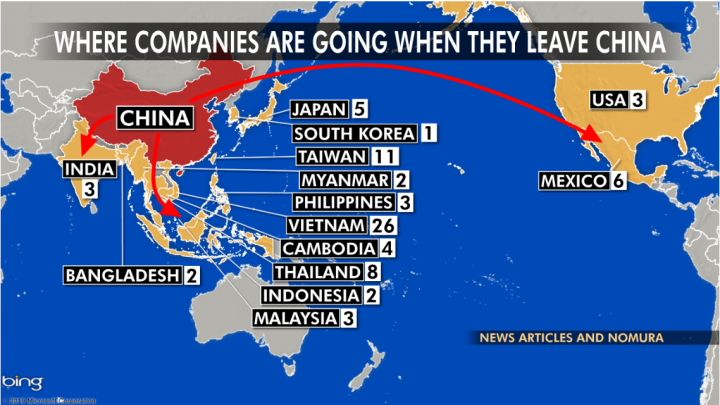
Hence, this is proof that India is not exactly the primary destination for companies quitting China.
Analysis: How is India going to woo companies this time?
- A total area of 461,589 hectares had been identified across India for the purpose of developing a land pool to lure businesses moving out of China.
- At present, investors keen on setting up a factory in India need to acquire land on their own. The process, in some cases, delays the project as it involves negotiating with small plot owners to part with their holding.
- Providing land with power, water and road access may help attract new investments to an economy that was slowing even before the virus hit, and is now staring at a rare contraction as a nationwide lockdown hit consumption.
- India also took up the chance to finally push through long-stalled reforms on land, labor and taxes. Some states even went as far as to completely scrapping labour laws for a certain period to woo companies to set up their firms in India.
-Source: The Hindu
GRASPING THE DEFENCE SELF-RELIANCE NETTLE
Focus: GS-III Indian Economy
India’s Dependence for Defence
- For the most part of 2010 to 2020 The India had the dubious distinction of being the world’s largest arms importer, accounting for about 12% of global arms imports.
- Saudi Arabia jumped to first place in 2018 and 2019, but India still takes over 9% of global imports.
- This external dependence for weapons, spares and, in some cases, even ammunition creates vulnerabilities during military crises.
An opportune moment
- The facts that new Defence Procurement Procedures (DPP) 2020 are under formulation and that we now have a Chief of Defence Staff (CDS) tasked with promoting indigenous equipment in the armed forces, provide a conducive backdrop to having a robust defence manufacturing capacity.
- The decision to notify a list of weapons systems for sourcing entirely from Indian manufacturers, the promise to progressively expand this list and a separate Budget provision for domestic capital procurement will encourage our private defence manufacturers.
- Missile systems such as Akash and Nag, the Light Combat Aircraft and the Light Combat Helicopter, artillery guns, radars, electronic warfare systems and armoured vehicles- are among platforms and subsystems, developed in India and qualified in trials. However, these face hurdles to their induction by our armed forces because of foreign competition.
- The government has promised a time-bound defence procurement process, overhauling trial and testing procedures and establishing a professional project management unit.
- The CDS could also examine them from a tri-service angle, to avoid redundancy of capacities across the services.
How far to push Self-Reliance?
- Corporatisation, including public listing of some units, ensures a more efficient interface of the manufacturer with the designer and end user.
- The thrust for indigenous research and development will coexist with the import of cutting-edge military technologies to obviate near-term defence vulnerabilities.
- At the same time, our defence planners will frame “realistic” specifications for their desired weapons platforms, based on the requirements of India’s defence strategy.
FDI impact
- The liberalisation of foreign direct investment in defence manufacturing, raising the limit under the automatic route to 74%, should open the door to more joint ventures of foreign and Indian companies for defence manufacturing in India.
- It would also sustain a beehive of domestic industrial activity in the research, design and manufacture of systems and sub-systems.
- Our companies, which have long been sub-contractors to prominent defence manufacturers abroad, would now get the opportunity to directly contribute to Indian defence manufacturing.
Analysis: Military budget of India
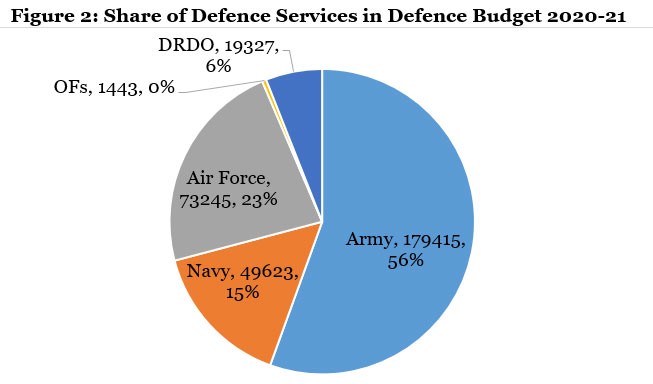
- The military budget of India is the portion of the overall budget of Union budget of India that is allocated for the funding of the Indian Armed Forces.
- The Indian Army accounts for more than half of the total defence budget of India, with most of the expenditure going to the maintenance of cantonments, salaries and pensions, instead of critical arms and ammunition.
- On 1 February 2020, the Finance Minister of India, Nirmala Sitharaman presented the budget. The allocation for defence during the fiscal year 2020-21 stood at ₹471,378 crores (US$65.86 Billions).
- This amounted to an increase of just under 7%.
- It may be seen from data of economic survey that Defence Budget as a percentage of GDP may appear to be decreasing due to increasing trend in the growth of GDP. However, it is increasing in absolute terms, implying higher spending.
India’s Defence Imports
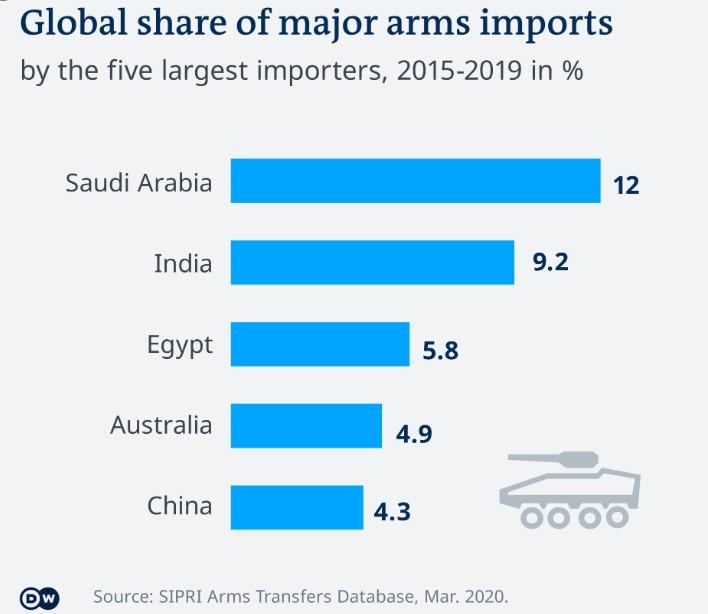
- India was the world’s second-largest arms importer from 2014-18, ceding the long-held tag as largest importer to Saudi Arabia, which accounted for 12% of the total imports during the period.
- However, Indian imports decreased by 24% between 2009-13 and 2014-18, partly due to delays in deliveries of arms produced under licence from foreign suppliers, such as combat aircraft ordered from Russia in 2001 and submarines ordered from France in 2008.
- Russia accounted for 58% of Indian arms imports in 2014–18, compared with 76% in 2009-13.
-Source: The Hindu
INDIA-CHINA CONFLICT IN LADAKH
Focus: GS-II International Relations
Introduction
The recent incidents at the Pangong Tso lake area between Indian and Chinese soldiers on the LAC can be considered to be a serious business between two nuclear armed trans-Himalayan neighbours that has implications beyond the region.
Line of Actual Control
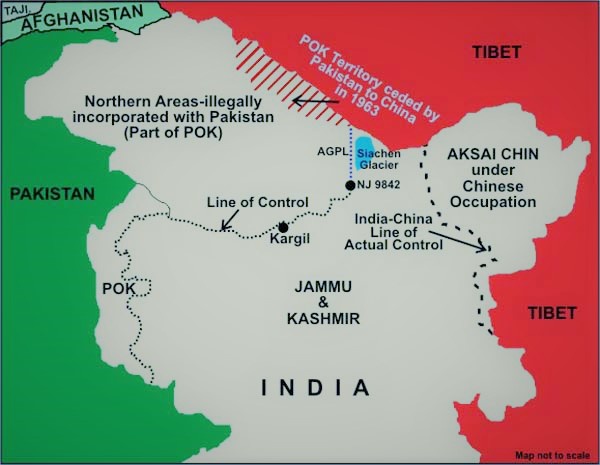
- The disputed boundary between India and China, also known as the Line of Actual Control (LAC), is divided into three sectors: western, middle and eastern.
- The countries disagree on the exact location of the LAC in various areas, so much so that India claims that the LAC is 3,488 km long while the Chinese believe it to be around 2,000 km long.
- The two armies try and dominate by patrol to the areas up to their respective perceptions of the LAC, often bringing them into conflict and leading to incidents such as those witnessed in Naku La in Sikkim earlier this month.
- The LAC mostly passes on the land, but Pangong Tso is a unique case where it passes through the water as well. The points in the water at which the Indian claim ends and Chinese claim begins are not agreed upon mutually.
The Pangong Tso lake
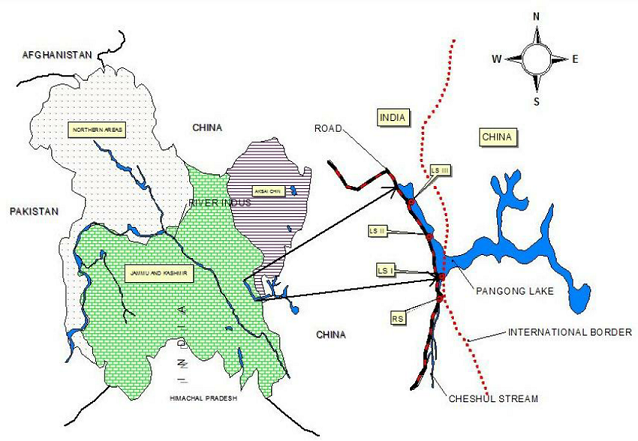
- Pangong Tso lake in eastern Ladakh has often been in the news, most famously during the Doklam standoff.
- Pangong Tso is a long narrow, deep, endorheic (landlocked) lake situated at a height of more than 14,000 ft in the Ladakh Himalayas. The western end of Tso lies 54 km to the southeast of Leh. The 135 km-long lake sprawls over 604 sq km in the shape of a boomerang, and is 6 km wide at its broadest point.
Tactical significance of the Panging Tso
- By itself, the lake does not have major tactical significance. But it lies in the path of the Chushul approach, one of the main approaches that China can use for an offensive into Indian-held territory.
- Indian assessments show that a major Chinese offensive, if it comes, will flow across both the north and south of the lake.
- During the 1962 war, this was where China launched its main offensive.
- Over the years, the Chinese have built motorable roads along their banks of the Pangong Tso.
Even during peacetime, the difference in perception over where the LAC lies on the northern bank of the lake, makes this contested terrain. - In 1999, when the Army unit from the area was moved to Kargil for Operation Vijay, China took the opportunity to build 5 km of road inside Indian territory along the lake’s bank.
Fingers in the lake
The barren mountains on the lake’s northern bank, called the Chang Chenmo, jut forward in major spurs, which the Army calls “fingers”.
India claims that the LAC is coterminous with Finger 8, but it physically controls area only up to Finger 4.
- Chinese use light vehicles on the road to patrol up to Finger 2, which has a turning point for their vehicles.
- If they are confronted and stopped by an Indian patrol in between, asking them to return, it leads to confusion, as the vehicles can’t turn back.
The Chinese have now stopped the Indian soldiers moving beyond Finger 2.
Confrontation on the water
- On the water, the Chinese had a major advantage until a few years ago — their superior boats could literally run circles around the Indian boats.
- But India purchased better Tampa boats some eight years ago, leading to a quicker and more aggressive response.
Out of bounds for tourists
- Tourists were not allowed at all at Pangong Tso until 1999, and even today, you need to obtain an Inner Line Permit from the office of the Deputy Commissioner at Leh.
- Tourists are only allowed up to Spangmik village, around 7 km into the lake.
-Source: Indian Express





